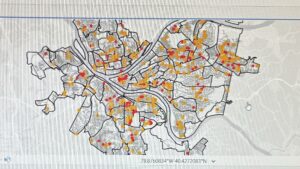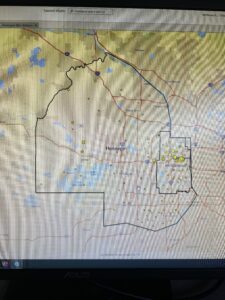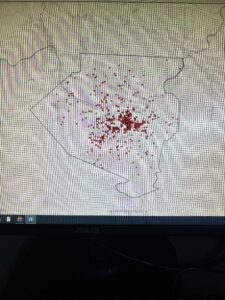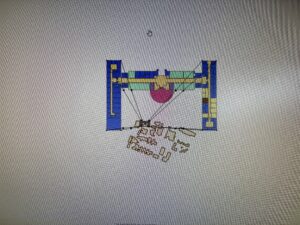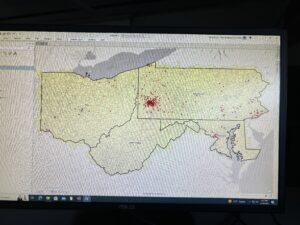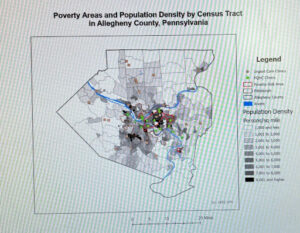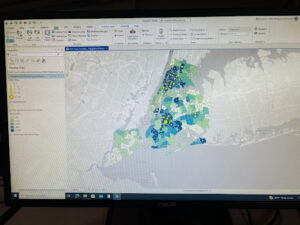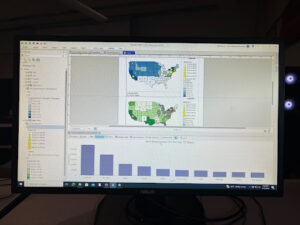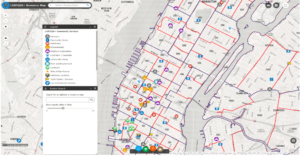CH4
Chapter four covers mapping density. “Mapping density lets you see the patterns of where things are concentrated. This helps you find areas that require action or meet your criteria or monitor changing conditions.” Mapping density is to highlight patterns more than the individual features that might be better represented in a different type of map. Mapping density is best represented using shades of colors to represent different ranges of data. The data available will determine what the map might look like. There are two ways to map density: by defined area or by density surface. A defined area can be shown using a dot map and the places with a higher density of dots represent the higher density of features on the map. Defined area map density would also be used if we were interested in how much of a feature is sequestered to a certain area. We might see this map type divided by state, county, country, or any other predetermined separation. The density surface is created in the GIS and shows the density without the predetermined separations. This map does require more work but is more accurate. GIS will calculate the density surface for you. You can determine what the cell size will be. If a cell is too large the map might be too vague, but a cell too small makes the map convoluted and hard to digest. A cell too small also takes a lot of time to process and can take up a lot of storage on the computer/external hard drive. The book gives a detailed description of how to calculate the proper cell size based on how much space is being shown on a map. A map that covers 1 sq. km would have a cell size of 100m. The search radius depends on what the goal of the map is. A search radius too small might not have enough significant features, but a search radius too large can lead to the map becoming too generalized. These types of maps allow the researchers to get a good picture, but it might not be the whole picture.
CH5
People map certain features on a map to determine what is inside the area. Politicians, police officers, and even business owners use these maps to decide whether or not to take action. If a business owner sees that in one area in a city, there are other businesses nearby that are doing well, they are more likely to try and open a branch in that general area. It’s necessary to determine how you will split your data into a single or multiple areas. A single area might be useful to determine if a hotspot is occurring. Multiple areas allow you to compare each and determine if there is a common theme spread amongst them. These areas might be zip codes or state parks. Defining each area and comparing it will give researchers the ability to identify interesting patterns within the maps. You can determine the type of map you need by identifying whether the individual feature is continuous or discrete. The book identifies three ways of finding what is inside the map. Drawing areas and features allows the researcher to highlight what features are inside and outside the boundaries. This is the quickest way to map, but it is strictly visual. Selecting the features inside an area can show the reader information about a single area but does not go deep enough to show several areas. Overlaying the areas and features is the most time-consuming method, however it is also the most detailed. This way finds features inside the areas. This does take the longest, but if a detailed map is what’s most important this is the map in question. Drawing areas can be difficult to decide on a map. A map either has discrete or continuous areas. Discrete areas are often quantitive data like types of injury or crimes in an area. Continuous areas might be more fluid like elevation, population, or even businesses in a specific area.
CH6
Chapter 6 tries to answer the question, “why map what’s nearby?” Traveling range can be determined not only by distance, but also by time, cost, or other factors. The three main ways of finding what’s nearby are straight-line distance, distance or cost over a network, and cost over a surface. Straight line distance is the most simple way for the GIS analysis to work. This type can only measure distance and provides only a rough estimate of the time that it would take a person to get to that destination. This might be used to determine the radius of a school or police station. A cost over a surface allows the researcher to combine different layers of features to determine the travel cost. This type specifically measures cost. It does require a lot more data than the previous type, but the calculation over a range is relatively reliable. The third type is distance or cost over a network. This type is a hybrid of the two previously mentioned methods. This method needs both locations of source features and information about the length or cost value of a particular area. This is the most precise method because it combines both travel distance and cost, but it requires a very accurate network layer that might be difficult to obtain. Calculating costs in GIS can be confusing. The last section of the book goes over how to calculate cost over a geographic surface. Cost can mean time, money, or other factors. Cost layers in GIS can be based on a single factor or using several. Once you have inputted all of the layers, GIS will combine them to determine the total cost. Each cell is given a cost and based on the type of map assigned a color or shade to represent the cost. Once GIS has determined the cost of each cell the researcher can manipulate the map to exclude costs, either too high or too low, and even exclude entire sections due to geographic concerns. The maps that GIS can make are so highly specialized that with the right data GIS can make whatever map the researcher wants.
